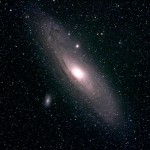To quote Douglas Adams… “Space is big. You just won’t believe how vastly, hugely, mind-bogglingly big it is.”
We are accustomed to using miles or kilometers when considering distance. These are the distances that we experience in our everyday lives. Driving to work or the supermarket, we do not travel very far compared to the distances faced by those who study the stars. Those wanting to discuss distances beyond our little planet, the distances to the stars and galaxies face a quandary… The universe is just too big, when using these familiar units the number of zeros become impractical and the numbers cease to be convenient, or even understandable. To express distances in the cosmos, astronomers just need a bigger tape measure.

In a few minutes light travels across our solar system, in a few years it can reach the nearby stars. Thus a distance unit that makes sense in astronomy… The light-year, the distance light travels in a single year. With this we have a convenient unit of distance, one that links the concepts of distance and time. A simple bit of math converts the light-year into familiar units… 9.45 trillion kilometers or 5.86 trillion miles.
Occasionally scientists will extend this idea, we can talk about light-seconds, or light minutes. For calculating the distances across the solar system, light minutes are often useful. If Mars was currently ten light-minutes away (it varies from 3 to 20 minutes), it will take ten minutes for a radio signal to reach a spacecraft in orbit around the red planet, and another ten minutes for the reply to return. You could also talk about light hours or light centuries, but in practice these units are seldom used.
| Kilometers | Miles | Light-years | Used for… | |
| Light-second | 299,792 | 186,000 | ||
| Light-minute | 17.9 million | 11.1 million | Distances within a solar system | |
| Light-year | 9.45 trillion | 5.86 trillion | 1 | Distances between stars |
| Parsec | 30.9 trillion | 19.2 trillion | 3.261564 | Distances between stars |
| Megaparsec | 3,261,564 | Distance between galaxies | ||
| Redshift | Size of the universe |
There are a couple other units in common use shown in the table. A parsec is the distance at which a star will shift one arc-second in parallax as the Earth makes its yearly orbit. If that did not make any sense to you, don’t worry about it. It is simply a convenient unit that astronomers have used for a long time, starting with the method by which the distances to the closest stars were first measured. Just remember that a parsec is about 3.26 light-years and is used to measure the distances between stars. It is a parallax-arc-second… A parsec.
At really large distances astronomers use another method to express distance, redshift. Like parsecs, redshift is derived from the measurement method rather than a more traditional concept of distance. We know that the universe is expanding. As it does, distant objects appear to be moving away from us. This causes a doppler shift in the light towards the red… redshift. By simply measuring the shift with a spectrograph we know the distance to the object. Redshift is simply expressed as the shift in wavelength observed in the spectra of an object. The resulting number is commonly used as an expression of distance.
Unfortunately redshift can not easily be converted into light-years, there are any number of complicating factors that prevent a simple mathematical conversion. These issues arise from the underlying structure and expansion of space-time. A correspondence can be put together if you make some assumptions about the structure of the universe. A redshift of 0.1 represents light travel time of around 1.2 billion years, while a redshift of 1 indicates 7.7 billion years. You quickly see that this is an exponential relationship, not a simple linear conversion. A redshift of seven would indicate the object emitted the light about 13 billion years ago, or about 700 million years after the big bang. The most distant energy we can detect with our instruments, the fading glow of the big-bang itself, has a redshift of 1089.
As you can see above, using light and time to measure distance naturally leads to a fascinating flip in thinking. If looking at an object a few light-years away, you must also realize you are looking back a few years in time. You are observing the object as it was when the light you are seeing started its journey. This is true for even relatively nearby objects… As our Sun is eight light minutes away, you are also looking back in time eight minutes every time you see the Sun in the sky. Nearby stars are dozens to hundreds of light-years away, a fair amount of time to look back. It is when looking at galaxies that this really becomes mindboggling. Even nearby galaxies are millions of light-years away, thus we are looking back in time millions of years. The telescope becomes a time machine, peering back into the history of our universe. A small, backyard telescope can easily look back millions of years. The big observatories can look back through much of the 13.7 billion year history of our universe.

